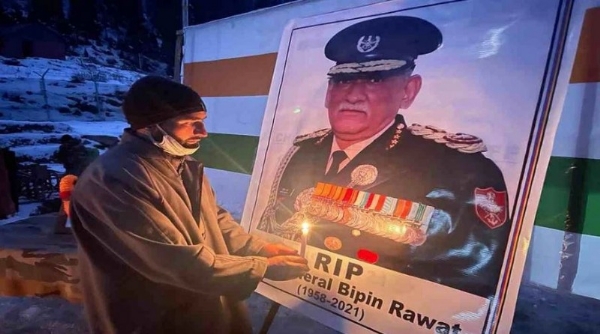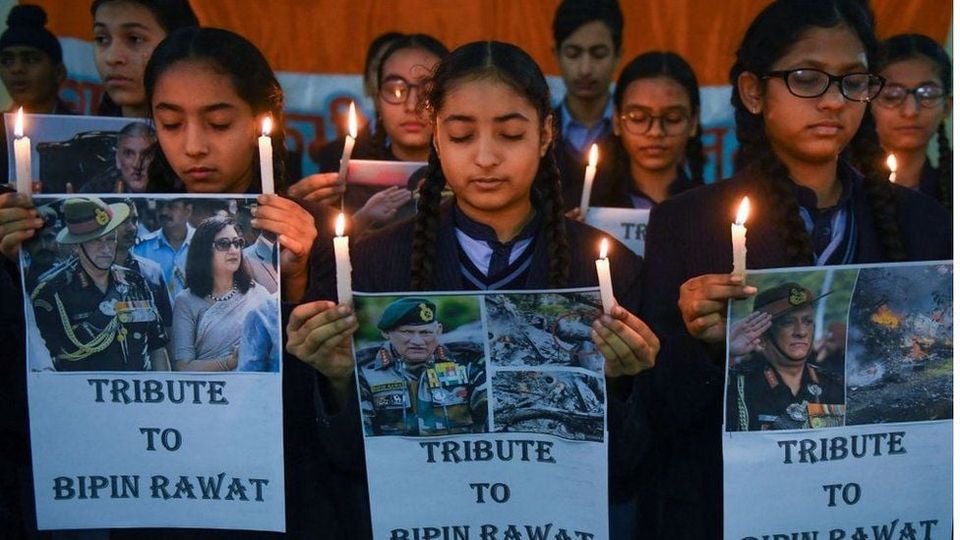A Tribute to a General - From a Common Man
As a General like Bipin Rawat came to symbolize a value that our nation represents now while being at the crossroads of history. A value unknown till one generation ago, a value we thought we may not see in our lifetime.
Total Views |
As a child, like many children, I too was fascinated with Generals. Their gallant uniforms, their medals, the authority, transports us to another world. They are the heroes who fight our enemies and stay awake at night to save us from bad people, children are told the world over. I am not aware it happens in India.
For too long, Indians have found it difficult to identify with army generals as national heroes or icons of our civilization. Our identifications were with figures who professed values antithetical to war and personalities whose habits symbolize passivity, with some of them hard to emulate in daily life. It has caused a guilt at a national level that has bound us, chained us.
Slavery and colonialism filled up the gap and the illusion that our driving away the British was not a military victory was drilled into us through every school textbook. Identifying with an army, the men who led it and won wars with military brilliance meant little, as it would lead to giving up our identification with ‘ahimsa’, our core USP that defined our national identity for most of twentieth century. We are only beginning to realize the shame and humiliation it caused to our national identity.

It was Abraham Lincoln who ended slavery but it was General Ulysses Grant whose brilliant tactics led the Confederates to surrender and lead to closure of a painful chapter. Lincoln mentioned about how many blunders he came close to that were undone by the stoic figure and personality of the General.
Man’s propensity for violence has produced Generals on both sides who fought for values characteristics of their societies. A General from Pakistan fights against India guided by a religious identity, greed and expansionism, while an Indian General fights to uphold ‘Dharma’ and values that are completely at odds with him. A General may be similar in personality to another one, yet completely opposite and bound by evil or goodness.
What are the Generals as persons and what values do they represent? As we shall see, a General like Bipin Rawat came to symbolize a value that our nation represents now while being at the crossroads of history. A value unknown till one generation ago, a value we thought we may not see in our lifetime.
To me and millions of others, General Bipin Rawat represented a General marked by a philosophy where India began to hit back at its enemies and not remaining silent and only doing ‘Kari ninda’. ‘Ghar me ghuske marenge’ began the battle cry during this period. The average Indian found a courage that he lacked before, a collective that was sleeping under the cocktail of ahimsa, secularism and passivity, a heady mixture that his words and strategies began to melt.
A study of greatest Generals of history makes interesting reading. The three greatest Generals regarded of all times are Hannibal, Alexandra and Napoleon. Hannibal because he led the largest army of his times consisting of men from seventeen nationalities who never rebelled against him. He crossed over the Alps into Italy, considered an impossible feat even today. He devised an army maneuver which almost every General has copied down to twentieth century.
Alexandra because with an army of little more than twenty five thousand he defeated Darius, who had an army of a million soldiers. Napoleon because of his strategies that destroyed larger armies and by the sheer power of will. All of them led to the creation of pride in their societies that symbolized their civilization.
I believe Bipin Rawat too was leading us into an era similar to the above where the psychic space of Indians would have been defined by military thoughts and not politicians who swear by ‘ahimsa’. Bipin Rawat was the first General to understand the need of Indians. The kind of a national hero that Douglas Macarthur became in USA, or Rommel in Germany, a Manekshaw or Jagjit Singh Arora could never become in India nor any of the numerous
Generals whose heroism was far too big to enlist here, never reached the status. Manekshaw died a painful, broken man in his last years. He didn’t get a proper funeral and respect deserving of the biggest military icon of India of the twentieth century.
General Bipin Rawat’s style as any defense strategist would tell us thought beyond the army and how to arouse the army spirit in every average Indian. His thinking was to preempt the enemy rather than wait for him to strike. He would hit back with a retaliation, something we Indians are learning to imbibe in our psyche if we have to survive surrounded by two fronts. In his time, the cry of the Indians changed from ‘kari ninda to ghar mein ghuske marenge’, a sea change that we Indians earlier thought of as heresy. No longer a nation which only played defensive, its land torn apart by violence and cunningness was willing to hold back but would hit back.
In the end, I want to say, "This is what we learned from you, General. So how do we all say goodbye to you?" We can only say, “Sleep well, General. You have left a nation and people who have learnt to hit back at its enemies and not wait in silence.”
This Article Was Originally Published Here
For too long, Indians have found it difficult to identify with army generals as national heroes or icons of our civilization. Our identifications were with figures who professed values antithetical to war and personalities whose habits symbolize passivity, with some of them hard to emulate in daily life. It has caused a guilt at a national level that has bound us, chained us.
Slavery and colonialism filled up the gap and the illusion that our driving away the British was not a military victory was drilled into us through every school textbook. Identifying with an army, the men who led it and won wars with military brilliance meant little, as it would lead to giving up our identification with ‘ahimsa’, our core USP that defined our national identity for most of twentieth century. We are only beginning to realize the shame and humiliation it caused to our national identity.
Throughout history, Generals have impacted the course of their nations more than any other group of leaders including India. They have inspired awe, fear and trepidation in entire societies and changed the course of a nation’s history, one that lasted for decades, sometimes centuries.
It was Abraham Lincoln who ended slavery but it was General Ulysses Grant whose brilliant tactics led the Confederates to surrender and lead to closure of a painful chapter. Lincoln mentioned about how many blunders he came close to that were undone by the stoic figure and personality of the General.
Man’s propensity for violence has produced Generals on both sides who fought for values characteristics of their societies. A General from Pakistan fights against India guided by a religious identity, greed and expansionism, while an Indian General fights to uphold ‘Dharma’ and values that are completely at odds with him. A General may be similar in personality to another one, yet completely opposite and bound by evil or goodness.
What are the Generals as persons and what values do they represent? As we shall see, a General like Bipin Rawat came to symbolize a value that our nation represents now while being at the crossroads of history. A value unknown till one generation ago, a value we thought we may not see in our lifetime.
To me and millions of others, General Bipin Rawat represented a General marked by a philosophy where India began to hit back at its enemies and not remaining silent and only doing ‘Kari ninda’. ‘Ghar me ghuske marenge’ began the battle cry during this period. The average Indian found a courage that he lacked before, a collective that was sleeping under the cocktail of ahimsa, secularism and passivity, a heady mixture that his words and strategies began to melt.
A study of greatest Generals of history makes interesting reading. The three greatest Generals regarded of all times are Hannibal, Alexandra and Napoleon. Hannibal because he led the largest army of his times consisting of men from seventeen nationalities who never rebelled against him. He crossed over the Alps into Italy, considered an impossible feat even today. He devised an army maneuver which almost every General has copied down to twentieth century.
Alexandra because with an army of little more than twenty five thousand he defeated Darius, who had an army of a million soldiers. Napoleon because of his strategies that destroyed larger armies and by the sheer power of will. All of them led to the creation of pride in their societies that symbolized their civilization.
I believe Bipin Rawat too was leading us into an era similar to the above where the psychic space of Indians would have been defined by military thoughts and not politicians who swear by ‘ahimsa’. Bipin Rawat was the first General to understand the need of Indians. The kind of a national hero that Douglas Macarthur became in USA, or Rommel in Germany, a Manekshaw or Jagjit Singh Arora could never become in India nor any of the numerous
Generals whose heroism was far too big to enlist here, never reached the status. Manekshaw died a painful, broken man in his last years. He didn’t get a proper funeral and respect deserving of the biggest military icon of India of the twentieth century.
The rise of General Bipin Rawat as the CDS, his two-front theory represented a sea change in the way Indian society has now begun to see its army, its Generals and in the process our country. The best symbol of that is the picture where children on the streets set up memorials for him with flowers. The culture of ‘charkha and ahimsa’ that defined us and the blindness it caused in our vision as a country prevented us from seeing it.
General Bipin Rawat’s style as any defense strategist would tell us thought beyond the army and how to arouse the army spirit in every average Indian. His thinking was to preempt the enemy rather than wait for him to strike. He would hit back with a retaliation, something we Indians are learning to imbibe in our psyche if we have to survive surrounded by two fronts. In his time, the cry of the Indians changed from ‘kari ninda to ghar mein ghuske marenge’, a sea change that we Indians earlier thought of as heresy. No longer a nation which only played defensive, its land torn apart by violence and cunningness was willing to hold back but would hit back.
In the end, I want to say, "This is what we learned from you, General. So how do we all say goodbye to you?" We can only say, “Sleep well, General. You have left a nation and people who have learnt to hit back at its enemies and not wait in silence.”
This Article Was Originally Published Here
